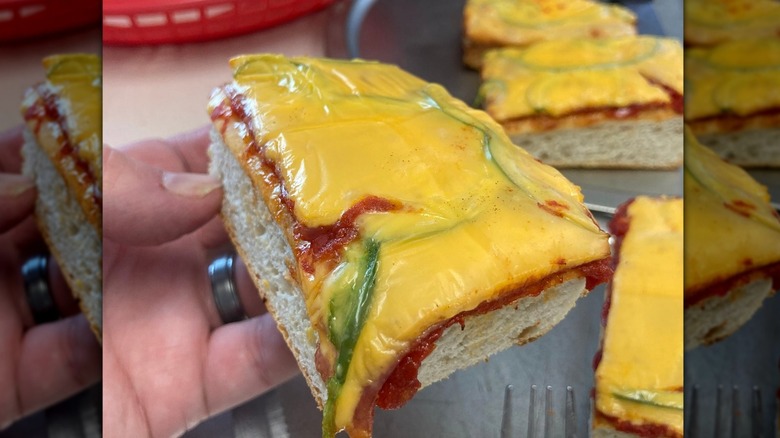Why Pennsylvania's Altoona Pizza Is So Controversial
Pizza purists, southern Italians, and New Yorkers, brace yourselves. The pizza you're about to read about is beloved by some, but considered an abomination by many, and is controversial any way you look at it. The subject of Altoona-style pizza is such a gastronomic curiosity that food writers, influencers, and other food lovers have flocked to its small Pennsylvania hometown to find out if it tastes as strange as it sounds.
This style of pizza has actually been around for decades, has a loyal fanbase, and even garnered the dedication of baseball team the Altoona Curve, which is A Double-A affiliate of the Pittsburgh Pirates. The pies are made in a square shape and served in square pieces, similar to what Americans know as Sicilian-style pizza. Like the Sicilian style, the crust for Altoona pizza is also thick and spongy, a little like focaccia bread. The next few parts are where it gets odd.
Like Detroit-style pizza, the toppings of Altoona pizza are placed on the crust below the cheese, and usually consist of tomato sauce, green bell pepper rings, and sliced salami. It's the cheese itself, however, that defines the style — slices of American cheese go on the pie, not mozzarella or other more conventional choices. To many U.S. residents, processed American cheese is perfectly acceptable to put on burgers and grilled cheese sandwiches, but when it comes to pizza, most consider it a shocking anomaly.
American cheese, please
Altoona-style pizza was created at the Altoona hotel in the 1950s, but the reason why anyone would think to top a pizza with American cheese — or Velveeta, which topped the earliest versions of the pies — is unclear. Perhaps it was out of curiosity, or it was all that was left in the cheese drawer after a busy weekend. Either way, the pizza caught on, and was a staple dish at the hotel until it burned down in 2013.
Several other eateries later carried on what was, by then, an Altoona tradition. Many variations have emerged over time, but most stay true to the basic format of the original pizza. As popular as the pizza is in its hometown, not everyone in the immediate or surrounding area has heard of it. Still, it's had glimmers of outside attention over the years. The town's local minor league baseball team, the Altoona Curve, draws many outsiders into the area during spring and summer. At one point, the team temporarily changed its name to the Altoona Pizzas, and redesigned their jerseys and logo in honor of the dish's increasing fame.
Love it or hate it, Altoona-style pizza has a dedicated following, as well as a good amount of online attention (including curiosity, celebration, and scrutiny). The prospect of trying it is bringing more and more curious folks to the charming mountain town, located two hours east of Pittsburgh.
Does American cheese have an unfair stigma?
When you think about it, Altoona-style pizza contains everything else that you'd find on other kinds of pizzas: crust, tomato sauce, toppings, and cheese. The ordering of these components is a tad unconventional, but it's really the use of "processed" cheese that people have a hard time swallowing. This is despite the fact that all cheese is processed, and American cheese is not made of plastic — it's real cheese with a few ingredients added to make it smoother and creamier when melted. The product has had a bad rap for a while now, but many foodies are saving personal judgment for after they've actually tried the cheese on an Altoona pie.
Road trippers should consider taking a trip to the picturesque community of Altoona and stop for a slice while they're there, but if you can't make it, you can easily create this type of pizza at home. And if you just can't bear the thought of using American cheese, consider topping your pie with mozzarella or provolone instead. Of course, it won't be true Altoona-style pizza without the correct cheese, so you may as well be making something else altogether. Open your mind and your mouth to an authentic Altoona pie, and you just might understand why it's captured the hearts of so many in its native area.



